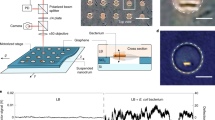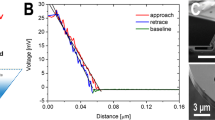Abstract
The widespread misuse of drugs has increased the number of multiresistant bacteria1, and this means that tools that can rapidly detect and characterize bacterial response to antibiotics are much needed in the management of infections. Various techniques, such as the resazurin-reduction assays2, the mycobacterial growth indicator tube3 or polymerase chain reaction-based methods4, have been used to investigate bacterial metabolism and its response to drugs. However, many are relatively expensive or unable to distinguish between living and dead bacteria. Here we show that the fluctuations of highly sensitive atomic force microscope cantilevers can be used to detect low concentrations of bacteria, characterize their metabolism and quantitatively screen (within minutes) their response to antibiotics. We applied this methodology to Escherichia coli and Staphylococcus aureus, showing that live bacteria produced larger cantilever fluctuations than bacteria exposed to antibiotics. Our preliminary experiments suggest that the fluctuation is associated with bacterial metabolism.
This is a preview of subscription content, access via your institution
Access options
Subscribe to this journal
Receive 12 print issues and online access
$259.00 per year
only $21.58 per issue
Buy this article
- Purchase on Springer Link
- Instant access to full article PDF
Prices may be subject to local taxes which are calculated during checkout



Similar content being viewed by others
References
Alanis, A. J. Resistance to antibiotics: are we in the post-antibiotic era? Arch. Med. Res. 36, 697–705 (2005).
Palomino, J. C. et al. Resazurin microtiter assay plate: simple and inexpensive method for detection of drug resistance in Mycobacterium tuberculosis. Antimicrob. Agents Chemother. 46, 2720–2722 (2002).
Diacon, A. H. et al. Time to detection of the growth of Mycobacterium tuberculosis in MGIT 960 for determining the early bactericidal activity of antituberculosis agents. Eur. J. Clin. Microbiol. Infect. Dis. 29, 1561–1565 (2010).
Boehme, C. C. et al. Rapid molecular detection of tuberculosis and rifampin resistance. N. Engl. J. Med. 363, 1005–1015 (2010).
Horvat, R. T. Review of antibiogram preparation and susceptibility testing systems. Hosp. Pharm. 45 (suppl. 1), S6–S9 (2010).
Boisen, A., Dohn, S., Keller, S. S., Schmid, S. & Tenje, M. Cantilever-like micromechanical sensors. Rep. Prog. Phys. 74, 036101 (2011).
Waggoner, P. S. & Craighead, H. G. Micro- and nanomechanical sensors for environmental, chemical, and biological detection. Lab on a Chip 7, 1238–1255 (2007).
Braun, T. et al. Quantitative time-resolved measurement of membrane protein–ligand interactions using microcantilever array sensors. Nature Nanotech. 4, 179–185 (2009).
Godin, M. et al. Cantilever-based sensing: the origin of surface stress and optimization strategies. Nanotechnology 21, 075501 (2010).
Ndieyira, J. W. et al. Nanomechanical detection of antibiotic mucopeptide binding in a model for superbug drug resistance. Nature Nanotech. 3, 691–696 (2008).
Lang, H. P. et al. An artificial nose based on a micromechanical cantilever array. Anal. Chim. Acta 393, 59–65 (1999).
Alvarez, M. & Lechuga, L. M. Microcantilever-based platforms as biosensing tools. Analyst 135, 827–836 (2010).
McKendry, R. et al. Multiple label-free biodetection and quantitative DNA-binding assays on a nanomechanical cantilever array. Proc. Natl Acad. Sci. USA 99, 9783–9788 (2002).
Reed, J., Wilkinson, P., Schmit, J., Klug, W. & Gimzewski, J. K. Observation of nanoscale dynamics in cantilever sensor arrays. Nanotechnology 17, 3873–3879 (2006).
Wali, R. P. et al. Fourier transform mechanical spectroscopy of micro-fabricated electromechanical resonators: a novel, information-rich pulse method for sensor applications. Sens. Actuat. B 147, 508–516 (2010).
Gfeller, K. Y., Nugaeva, N. & Hegner, M. Rapid biosensor for detection of antibiotic-selective growth of Escherichia coli. Appl. Environ. Microbiol. 71, 2626–2631 (2005).
Barton, R. A. et al. Fabrication of a nanomechanical mass sensor containing a nanofluidic channel. Nano Lett. 10, 2058–2063 (2010).
Park, K. et al. Measurement of adherent cell mass and growth. Proc. Natl Acad. Sci. USA 107, 20691–20696 (2010).
Oden, P. I., Chen, G. Y., Steele, R. A., Warmack, R. J. & Thundat, T. Viscous drag measurements utilizing microfabricated cantilevers. Appl. Phys. Lett. 68, 3814–3816 (1996).
Kasas, S., Longo, G., Alonso-Sarduy, L. & Dietler, G. Nanoscale motion detector. Swiss patent PCT/IB2011054553 (2011).
Kaldalu, N., Mei, R. & Lewis, K. Killing by ampicillin and ofloxacin induces overlapping changes in Escherichia coli transcription profile. Antimicrob. Agents Chemother. 48, 890–896 (2004).
Reed, J., Troke, J. J., Schmit, J., Han, S., Teitell, M. A. & Gimzewski, J. K. Live cell interferometry reveals cellular dynamism during force propagation. ACS Nano 2, 841–846 (2008).
Sanchez, T., Chen, D. T. N., DeCamp, S. J., Heymann, M. & Dogic, Z. Spontaneous motion in hierarchically assembled active matter. Nature 491, 431–434 (2012).
Li, Y. et al. LPS remodeling is an evolved survival strategy for bacteria. Proc. Natl Acad. Sci. USA 109, 8716–8721 (2012).
Lenn, T., Leake, M. C. & Mullineaux, C. W. Clustering and dynamics of cytochrome bd-I complexes in the Escherichia coli plasma membrane in vivo. Mol. Microbiol. 70, 1397–1407 (2008).
Spector, J. Mobility of BtuB and OmpF in the Escherichia coli outer membrane: implications for dynamic formation of a translocon complex. Biophys. J. 99, 3880–3886 (2010).
Boiangiu, C. D. et al. Sodium ion pumps and hydrogen production in glutamate fermenting anaerobic bacteria. J. Mol. Microbiol. Biotechnol. 10, 105–119 (2005).
Dimroth, P., von Ballmoos, C. & Meier, T. Catalytic and mechanical cycles in F-ATP synthases—fourth in the cycles review series. EMBO Rep. 7, 276–282 (2006).
Fournier, M. F., Sauser, R., Ambrosi, D., Meister, J-J. & Verkhovsky, A. B. Force transmission in migrating cells. J. Cell Biol. 188, 287–297 (2010).
Rubinstein, B., Fournier, M. F., Jacobson, K., Verkhovsky, A. B. & Mogilner, A. Actin-myosin viscoelastic flow in the keratocyte lamellipod. Biophys. J. 97, 1853–1863 (2009).
Schneider, S. W. et al. Continuous detection of extracellular ATP on living cells by using atomic force microscopy. Proc. Natl Acad. Sci. USA 96, 12180–12185 (1999).
Radmacher, M., Fritz, M., Hansma, H. G. & Hansma, P. K. Direct observation of enzyme-activity with the atomic-force microscope. Science 265, 1577–1579 (1994).
Pelling, A. E., Sehati, S., Gralla, E. B., Valentine, J. S. & Gimzewski, J. K. Local nanomechanical motion of the cell wall of Saccharomyces cerevisiae. Science 305, 1147–1150 (2004).
Pelling, A. E., Sehati, S., Gralla, E. B. & Gimzewski, J. K. Time dependence of the frequency and amplitude of the local nanomechanical motion of yeast. Nanomed. Nanotechnol. Biol. Med. 1, 178–183 (2005).
Sezonov, G., Joseleau-Petit, D. & D'Ari, R. Escherichia coli physiology in Luria–Bertani broth. J. Bacteriol. 189, 8746–8749 (2007).
Acknowledgements
This work was supported by the Fond National Suisse through the FN-CR 32I3-130676 and Swiss ISJRP 122941 grants. The authors thank Ch. Gerber, H. P. Lang and F. Huber for confirming the validity of the technique using a different experimental set-up. The authors also thank G. Foffi and P. De Los Rios for critical discussions and for reviewing the manuscript, as well as J-M. Vesin for his help in the preliminary data processing.
Author information
Authors and Affiliations
Contributions
S.K., G.L., L.A.S. and G.D. designed the study. G.L., J.N. and L.A.S. performed the nanomotion sensor analyses and produced the LabVIEW software. G.L., L.A.S. and G.D. analysed the nanomotion data. G.L. and J.N. performed the glucose experiments. S.K. produced the finite elements model (FEM). G.D. performed the theoretical calculations. G.L. and S.K. collected and analysed the AFM and optical data. L.M.R. performed the MIC and MBC determination. A.B. and A.T. provided the bacteria. A.B., A.T. and L.M.R. provided the microbiological background. G.L. wrote the paper. All authors discussed the results and commented on the manuscript.
Corresponding author
Ethics declarations
Competing interests
The authors declare no competing financial interests.
Supplementary information
Supplementary information
Supplementary information (PDF 1480 kb)
Supplementary movie S1
Supplementary movie S1 (MP4 2524 kb)
Supplementary movie S2
Supplementary movie S2 (MP4 9049 kb)
Rights and permissions
About this article
Cite this article
Longo, G., Alonso-Sarduy, L., Rio, L. et al. Rapid detection of bacterial resistance to antibiotics using AFM cantilevers as nanomechanical sensors. Nature Nanotech 8, 522–526 (2013). https://doi.org/10.1038/nnano.2013.120
Received:
Accepted:
Published:
Issue Date:
DOI: https://doi.org/10.1038/nnano.2013.120
This article is cited by
-
Rapid and visual identification of β-lactamase subtypes for precision antibiotic therapy
Nature Communications (2024)
-
Isogeometric Analysis for the Arbitrary AFG Microbeam with Two-Phase Nonlocal Stress-Driven Model
Acta Mechanica Solida Sinica (2024)
-
Accurate and rapid antibiotic susceptibility testing using a machine learning-assisted nanomotion technology platform
Nature Communications (2024)
-
Single-cell pathogen diagnostics for combating antibiotic resistance
Nature Reviews Methods Primers (2023)
-
Nanomechanical vibration profiling of oocytes
Nano Research (2023)



